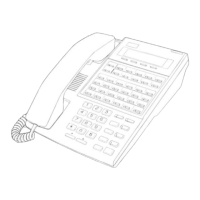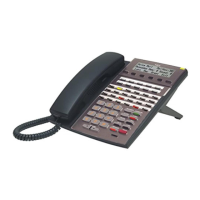
Do you have a question about the NEC Univerge SV9500 and is the answer not in the manual?
| Unified Communications | Yes |
|---|---|
| VoIP Support | Yes |
| Scalability | Highly Scalable |
| SIP Support | Yes |
| TDM Support | Yes |
| Mobility | Yes |
| Operating System | Proprietary |
| System Type | IP-PBX |
| Networking | IP Networking |
| Redundancy | Yes |
| Supported Protocols | SIP, H.323, ISDN, QSIG |
| VoIP Codecs | G.711, G.722, G.729 |
| Integration | Third-party applications and systems |
| Dimensions | Varies depending on configuration |
| Weight | Varies depending on configuration |
| Security | Advanced security features |
| Power Supply | Redundant Power Supply Option |
Visual identification of physical keys and components on the DT830G terminal.
Detailed technical specifications for DT830G models (ITZ and ITZ-DG series).
Detailed identification and description of each key and part of the DT830G terminal.
Explanation of phone startup procedures and menu screen navigation.
Explains the dynamic functions of soft keys adapting to the telephone's state.
Instructions for installing and removing the line key set unit and card.
Procedures for connecting the AC adapter and LAN cable to the telephone.
Steps for attaching an optional directory card for abbreviated dialing tables.
Adjusting handset receiver volume, speaker volume, and ringer tone using keys.
Feature to display characters in a double height on the LCD.
Controls for microphone, call indicator lamp, and dial mode selection.
Enabling/disabling off-hook ringing and headset ringing via the menu.
Steps for logging into and out of the telephone system.
Procedures for making external, internal, and answering calls.
How to place calls on hold and transfer them to other extensions.
Setting up and using one-touch speed dialing for stations and systems.
Managing system and local phonebooks, searching, and adding entries.
Viewing, making calls from, and managing call history records.
Step-by-step guide to adding new entries to the personal directory.
Methods to search directory entries by group, name, number, or memory ID.
Instructions for modifying existing directory entries, including names and numbers.
Procedures to remove all or specific entries from the directory.
How to access and view missed, outgoing, and incoming call records.
Procedures to redial numbers directly from the call history.
Adding call history entries to the personal directory for easier access.
Ways to start and use the Photo Frame application.
Visual examples and key controls for the Photo Frame application.
Connecting and using Bluetooth features with smart devices.
Switching between Wired Telephone and Mobile Phone modes.
Functionality and requirements for recording calls via USB.
Steps to play back recorded calls from call history.
Procedures for deleting single or all recorded calls.
Instructions for connecting the headset to the telephone.
Basic operations and call handling using the headset.
Steps to answer an incoming call using the headset.
How to adjust the ringer volume for the headset.
Procedures for operating the wireless headset for calls.
Overview of menu items and their descriptions for the DT830G (CG) model.
Overview of menu items and their descriptions for the DT830G (DG) model.
System requirements for using the Web Programming feature.
Steps to access and log into the Web Programming interface.
Example of changing ringer tone via Web Programming interface.











